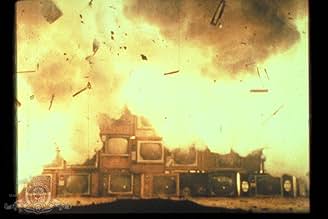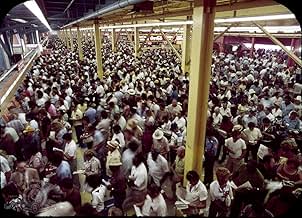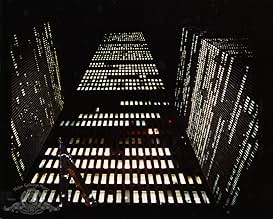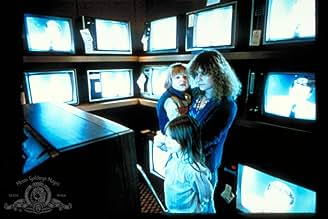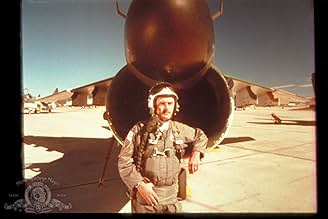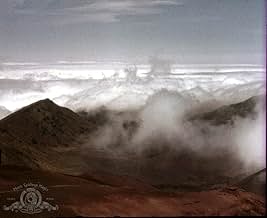VALUTAZIONE IMDb
8,2/10
43.411
LA TUA VALUTAZIONE
Una raccolta di fenomeni fotografati sapientemente. Filmati che si concentrano sulla natura, l'umanità e il rapporto tra loro.Una raccolta di fenomeni fotografati sapientemente. Filmati che si concentrano sulla natura, l'umanità e il rapporto tra loro.Una raccolta di fenomeni fotografati sapientemente. Filmati che si concentrano sulla natura, l'umanità e il rapporto tra loro.
- Regia
- Sceneggiatura
- Star
- Premi
- 6 vittorie e 1 candidatura in totale
Edward Asner
- Self - On TV
- (filmato d'archivio)
- (non citato nei titoli originali)
Pat Benatar
- Self
- (filmato d'archivio)
- (non citato nei titoli originali)
Jerry Brown
- Self - On TV
- (filmato d'archivio)
- (non citato nei titoli originali)
Johnny Carson
- Self - On TV
- (filmato d'archivio)
- (non citato nei titoli originali)
Dick Cavett
- Self - On TV
- (filmato d'archivio)
- (non citato nei titoli originali)
Marilyn Chambers
- Self - On TV
- (filmato d'archivio)
- (non citato nei titoli originali)
Sammy Davis Jr.
- Self - On TV
- (filmato d'archivio)
- (non citato nei titoli originali)
Lou Dobbs
- Self - On TV
- (filmato d'archivio)
- (non citato nei titoli originali)
Thomas Dolby
- Self - On TV
- (filmato d'archivio)
- (non citato nei titoli originali)
Linda Ellerbee
- Self - On TV
- (filmato d'archivio)
- (non citato nei titoli originali)
Jerry Falwell
- Self - On TV
- (filmato d'archivio)
- (non citato nei titoli originali)
Mark J. Goodman
- Self - On TV
- (filmato d'archivio)
- (non citato nei titoli originali)
Ted Koppel
- Self - On TV
- (filmato d'archivio)
- (non citato nei titoli originali)
Peter Sellers
- Self - On TV
- (filmato d'archivio)
- (non citato nei titoli originali)
Bill Tush
- Self - On TV
- (filmato d'archivio)
- (non citato nei titoli originali)
Recensioni in evidenza
Godfrey Reggio's Koyaanisqatsi (1983) is a film with no actors, no storyline, and no dialogue. The only things we see during the experimental documentary's 87 minutes are natural landscapes, images of cities, and real people going about their regular lives. Yet from the very beginning, when we see the title of the film appear in blood-red characters and hear the voice of a bass soloist chanting the title like an incantation, it is difficult not to be swept away in captivation.
Filmed between 1977 and 1982, Reggio's film was noticed by directing great Francis Ford Coppola who eventually agreed to finance the project and give it chances for distribution. Minimalist composer Philip Glass was optioned to compose the score, and the result was, quite simply, astounding.
Koyaanisqatsi is a collection of familiar images presented through tinted lenses (figuratively speaking). The experimental nature of the project can be seen in the reduced and augmented speeds of images, the use of carefully manipulated edits, and the use of Glass's score to create ambience. There are times when the film exhibits an almost surreal quality more indicative of a twisted, futuristic, dystopian sci-fi epic than of our mundane world.
This is, however, what makes Koyaanisqatsi so successful. In presenting our world in a disquieting, unflattering light, the film forces us to ruminate on our place in the universe and the consequences of many of our actions. The film starts with serene, austere images of mountains, oceans, and forests, and the repetitiveness of Glass's score does not bore us nor call attention to itself, but simply washes over us, entrancing us and instilling a sense of tranquility.
It is not long before the untainted images are replaced by nuclear power plants, highways, skyscrapers, rubble, fire and ash, and hoards of ant-like beings (humans, of course) scurrying through modern urbanity. Most times, humans are filmed at low-frame settings (making for faster speeds), and as a result, they seem frenzied, compulsively making their way through the cities in a manner that seems more conditioned than voluntary.
Glass's score responds by heightening its tension and adding a semi-brutal nature to its repetitiveness. It is somewhat aversive, but at the same time exhibits a humorous and mocking quality. By cramming together so many images of humans behaving more like lab rats than higher, thinking beings and increasing the satirical nature of the score, the film invites us to consider just how depersonalized, mechanized, and out-of-control many aspects of our life are.
The conclusion of the film contrasts against the blackly comic nature of the previous section by instilling a sense of mourning and warning. As such, there is undoubtedly a political and environmental component inherent in this film, but this is the aspect that is, in my mind, most often misunderstood. Many critics (mostly detractors) have interpreted Koyaanisqatsi as a call to action, an invective that demands that we atone for the rape-like pillaging the human race has thrusted upon the natural environment. Following from this, these critics claim that the film's message is that we would enjoy the planet more if we were not here at all, thus presenting a contradiction, since we would not be here to enjoy it.
In my own personal view, the flaw here resides in viewing the film as a tirade and a call to action. I find Koyaanisqatsi very clearly to be not a cry for reform, but a demand for awareness and meditation. There is an inevitability in the actions of human beings and their disregard for the care of their surroundings, and the wonderful thing about this film is that it forces you to experience the consequences and at least take notice of what each of us is contributing. It does not let you get away with indifference and nonchalance.
For me, however, the political component is less important than the stylistic component, which is one near and dear to my heart: the use of music to enhance the forcefulness of images. I acknowledge the fact that some will not be able to stand the repetitiveness of Philip Glass's score (and it is very repetitive at some points). But if one can consider the motive behind the repetition, the music ceases to be oppressive and becomes sublime and entrancing. The score adds impact to an already stunning array of unforgettable images, the details of which I will not go into, so that one may see the film with fresh eyes.
I saw Koyaanisqatsi for the first time at a performance in which the visuals were projected onto a giant screen with the soundtrack being supplied by Glass and his ensemble, who had come for a live performance. I had barely made it in time, since I struggled to find a parking space and was drenched from running in the rain. The moment the film started, however, all of the accumulated tensions in my body completely dissipated. It was not at all a cerebral experience, but an instinctive one in which I enjoyed the images and sounds for their own sakes.
When I left the performance, I was in a hypnotic daze, transfixed by what I had just seen. My initial impressions haven't changed to this day. I loved this film, and while the political and environmental concerns it addresses are important, what really makes this film for me is the instinctive, visceral power of its images and sounds. Koyaanisqatsi maroons its audience in an alternate version of reality that sheds disturbing light on our lives, and yet at the same time, it produces an unforgettable cinematic experience that is pervasively engrossing.
Filmed between 1977 and 1982, Reggio's film was noticed by directing great Francis Ford Coppola who eventually agreed to finance the project and give it chances for distribution. Minimalist composer Philip Glass was optioned to compose the score, and the result was, quite simply, astounding.
Koyaanisqatsi is a collection of familiar images presented through tinted lenses (figuratively speaking). The experimental nature of the project can be seen in the reduced and augmented speeds of images, the use of carefully manipulated edits, and the use of Glass's score to create ambience. There are times when the film exhibits an almost surreal quality more indicative of a twisted, futuristic, dystopian sci-fi epic than of our mundane world.
This is, however, what makes Koyaanisqatsi so successful. In presenting our world in a disquieting, unflattering light, the film forces us to ruminate on our place in the universe and the consequences of many of our actions. The film starts with serene, austere images of mountains, oceans, and forests, and the repetitiveness of Glass's score does not bore us nor call attention to itself, but simply washes over us, entrancing us and instilling a sense of tranquility.
It is not long before the untainted images are replaced by nuclear power plants, highways, skyscrapers, rubble, fire and ash, and hoards of ant-like beings (humans, of course) scurrying through modern urbanity. Most times, humans are filmed at low-frame settings (making for faster speeds), and as a result, they seem frenzied, compulsively making their way through the cities in a manner that seems more conditioned than voluntary.
Glass's score responds by heightening its tension and adding a semi-brutal nature to its repetitiveness. It is somewhat aversive, but at the same time exhibits a humorous and mocking quality. By cramming together so many images of humans behaving more like lab rats than higher, thinking beings and increasing the satirical nature of the score, the film invites us to consider just how depersonalized, mechanized, and out-of-control many aspects of our life are.
The conclusion of the film contrasts against the blackly comic nature of the previous section by instilling a sense of mourning and warning. As such, there is undoubtedly a political and environmental component inherent in this film, but this is the aspect that is, in my mind, most often misunderstood. Many critics (mostly detractors) have interpreted Koyaanisqatsi as a call to action, an invective that demands that we atone for the rape-like pillaging the human race has thrusted upon the natural environment. Following from this, these critics claim that the film's message is that we would enjoy the planet more if we were not here at all, thus presenting a contradiction, since we would not be here to enjoy it.
In my own personal view, the flaw here resides in viewing the film as a tirade and a call to action. I find Koyaanisqatsi very clearly to be not a cry for reform, but a demand for awareness and meditation. There is an inevitability in the actions of human beings and their disregard for the care of their surroundings, and the wonderful thing about this film is that it forces you to experience the consequences and at least take notice of what each of us is contributing. It does not let you get away with indifference and nonchalance.
For me, however, the political component is less important than the stylistic component, which is one near and dear to my heart: the use of music to enhance the forcefulness of images. I acknowledge the fact that some will not be able to stand the repetitiveness of Philip Glass's score (and it is very repetitive at some points). But if one can consider the motive behind the repetition, the music ceases to be oppressive and becomes sublime and entrancing. The score adds impact to an already stunning array of unforgettable images, the details of which I will not go into, so that one may see the film with fresh eyes.
I saw Koyaanisqatsi for the first time at a performance in which the visuals were projected onto a giant screen with the soundtrack being supplied by Glass and his ensemble, who had come for a live performance. I had barely made it in time, since I struggled to find a parking space and was drenched from running in the rain. The moment the film started, however, all of the accumulated tensions in my body completely dissipated. It was not at all a cerebral experience, but an instinctive one in which I enjoyed the images and sounds for their own sakes.
When I left the performance, I was in a hypnotic daze, transfixed by what I had just seen. My initial impressions haven't changed to this day. I loved this film, and while the political and environmental concerns it addresses are important, what really makes this film for me is the instinctive, visceral power of its images and sounds. Koyaanisqatsi maroons its audience in an alternate version of reality that sheds disturbing light on our lives, and yet at the same time, it produces an unforgettable cinematic experience that is pervasively engrossing.
This movie has no script, just visions and music. It is very nice to watch. The photography is amazing. This, along with the music, make it a very surreal experience to watch. I bought the DVD and just love it. The music is terrific and the commentary in the special features section is just out of this world.
10jotix100
Godfrey Reggio's magnificent documentary "Koyaanitsqatsi" was an amazing experience when it first came out more than twenty years ago. Watching for a second time, this time in DVD format, one realizes how this movie makes the case that it must be seen in the big screen in order to get all the brilliant cinematography in its proper perspective. Even watching it in a 32 plasma screen, one realizes it pales in comparison when projected on a larger movie theater screen.
The images that are presented in the film are just beyond belief. The fantastic music score by that genius, Phillip Glass, compliments and enhances our experience. This film will live forever in spite of some of the comments submitted to this forum, because it deals with universal themes that will stay with us on this planet while human life will exist. This was pioneer movie making that later on became main stream. The originality being in the way the director presents the different sections in the film with some unusual photography that, while imitated, remains the standard for comparison with any new so called latest technique and innovation.
Kudos to Mr. Reggio, Mr. Glass and the people behind this gorgeous film.
The images that are presented in the film are just beyond belief. The fantastic music score by that genius, Phillip Glass, compliments and enhances our experience. This film will live forever in spite of some of the comments submitted to this forum, because it deals with universal themes that will stay with us on this planet while human life will exist. This was pioneer movie making that later on became main stream. The originality being in the way the director presents the different sections in the film with some unusual photography that, while imitated, remains the standard for comparison with any new so called latest technique and innovation.
Kudos to Mr. Reggio, Mr. Glass and the people behind this gorgeous film.
10epsilon3
Make no mistake -- you need to get into the right mood to properly enjoy this film. Try watching it with your cynical or populist friends and they'll pour scorn upon it. Don't try to convince others to 'get it' as they won't.
The best thing to do is to turn off all of the lights, pump up the sound and absorb yourself in the spectacle that unfolds on the screen. If you do this, you'll experience one of the most breathtaking, moving and exciting pieces of art ever. There are few films that reach these heights -- 2001: A Space Odyssey is the only one that instantly comes to mind.
Don't analyse it until it's finished. Talking through it will ruin it. I've found that the film works best on an emotional level so switch your brain off and just watch and listen. By the time it's finished, you'll feel like you've been on an exhausting and exhilarating journey that you'll want to take again not long afterwards.
The best thing to do is to turn off all of the lights, pump up the sound and absorb yourself in the spectacle that unfolds on the screen. If you do this, you'll experience one of the most breathtaking, moving and exciting pieces of art ever. There are few films that reach these heights -- 2001: A Space Odyssey is the only one that instantly comes to mind.
Don't analyse it until it's finished. Talking through it will ruin it. I've found that the film works best on an emotional level so switch your brain off and just watch and listen. By the time it's finished, you'll feel like you've been on an exhausting and exhilarating journey that you'll want to take again not long afterwards.
A very beautiful flow of clips, even though some of them should frighten more than intrigue.The tempo is also part of what makes is so captivating. The clips slowly builds up and creates an alarming story. At the same time every sequence stands on its own. The lack of words gives it an almost alien view of earth and man's relationship to the planet. Together with the score by Philip Glass it sucked me in and I have rarely been so focused on every frame throughout an entire movie. It must have been quite amazing to see this in a movie theater back in the 80's with the big screen, speakers and also i guess in a time when similar creations were more scarce than now. It's by far the most visual movie I have seen and the fact that it only relies on images and music to tell a story made it bypass my rational filters and made me fully present in the moment for 86 minutes straight.
Lo sapevi?
- QuizGodfrey Reggio was hooked on Philip Glass doing the music. He approached Glass through a mutual friend, and Glass replied, "I don't do film music." Reggio persisted, and finally the friend told Glass that the tenacious guy was not going to go away without at least an audience. Glass relented, though he still insisted he wasn't doing the music. Reggio put together a photo montage with Glass' music as the soundtrack, which he presented to Glass at a private screening in New York. Immediately following the screening, Glass agreed to score the film.
- BlooperThe two explosions at about 18 minutes into the film were shot with anamorphic lenses and not properly desqueezed for the film's 1.85:1 aspect ratio.
- Citazioni
[last lines]
title card: Translation of the Hopi Prophecies sung in the film: "If we dig precious things from the land, we will invite disaster." - "Near the Day of Purification, there will be cobwebs spun back and forth in the sky." - "A container of ashes might one day be thrown from the sky, which could burn the land and boil the oceans."
- Curiosità sui creditiEnd credits go over mashed voice recordings in English ranging from call operator answers to television news.
- ConnessioniEdited into Wide Awake (2006)
I più visti
Accedi per valutare e creare un elenco di titoli salvati per ottenere consigli personalizzati
Dettagli
- Data di uscita
- Paese di origine
- Sito ufficiale
- Lingue
- Celebre anche come
- Koyaanisqatsi: Life Out of Balance
- Luoghi delle riprese
- San Onofre Nuclear Generating Station, San Diego County, California, Stati Uniti(as seen from San Onofre State Beach)
- Aziende produttrici
- Vedi altri crediti dell’azienda su IMDbPro
Botteghino
- Lordo Stati Uniti e Canada
- 1.723.872 USD
- Lordo in tutto il mondo
- 1.728.699 USD
Contribuisci a questa pagina
Suggerisci una modifica o aggiungi i contenuti mancanti

Divario superiore
By what name was Koyaanisqatsi (1982) officially released in India in Hindi?
Rispondi

